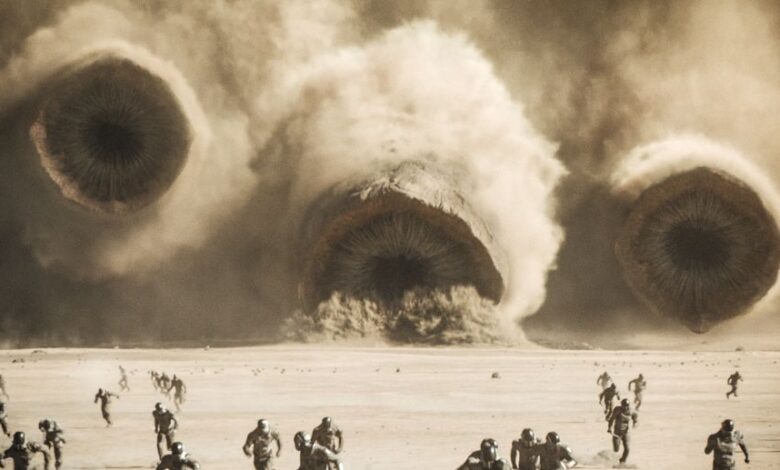Dune: I Want to See the Most Batsh*t Thing From the Books on the Big Screen


Dune: Part Two is chock full of deeply weird images. The film boasts giant sandworms, intelligent telepathic babies in utero, Harkkonen coliseum jesters, sadistic Austin Butler, and even proof that stringed instruments survive well into the year 10,901! Still, the most batshit image from the Dune novels has yet to hit the big screen. If you ask me, I don’t think Warner Bros. nor director Denis Villeneuve are brave enough to give it to audiences. Since there’s a chance we may never see it, I must take this opportunity to tell you about… the sandworm man.
Before we get into it, I should warn you that we are about to enter heavy spoiler territory for Dune: Messiah and beyond. Following Dune: Part Two‘s cliffhanger, the second book in the Dune series would surely serve as the source material for the unannounced (but likely) third Dune film. Dune: Messiah introduces the character that will become the sandworm man—I’ll explain in a moment, I promise!—in subsequent Dune books, meaning that we might need a fourth or a fifth film to even see him. But as my coworker and number-one Dune fan Adrienne Westenfeld suggested, there’s a very good chance that we could see this monstrosity in Dune: Messiah‘s visions of the future. So, it’s your move, Warner Bros.
You may have already seen the image circulating on social media. It’s not something you would forget. The art is featured in old paperback versions of God Emperor of Dune, depicting an incredibly phallic-looking worm with a human head. (Look below, if you dare.) This man/worm/wiggly nightmare is Paul’s son, Leto II, and he’s easily one of the most unnerving things I’ve ever seen. Putting him in a movie would almost necessitate an NC-17 rating. Forget Butler’s egghead! There’s no getting around the truth of Leto II: he’s a giant penis with a face.
To Frank Herbert’s credit, I think that imagery was exactly what he was going for. By fulfilling the prophesy and becoming emperor, Paul Atreides succumbed to his worst fears and ignited a bloody holy war. Before we reach Leto’s starring turn in the fourth novel, God Emperor of Dune, Paul finally learns that violence begets more violence. Lost, he walks into the desert and leaves his empire to his children. Paul’s son, Leto II, realizes that the only way to save humanity is to become a bane for all of humanity to hate and rise against. So, he fuses with the sandworms and becomes a giant, immortal, phallic-looking sandworm man. Somehow, the imagery is so damn silly that Herbert gets the message across.
As I scrolled through the social media discourse on Dune: Part Two this week, it seems that many theatergoers need this message as well. An alarming amount of viewers did not walk away from the sequel thinking that Dune is a warning against placing your trust in messianic figures. “Just read a really baffling article calling out the white savior narrative of DUNE 2,” The Ringer writer Joanna Robinson posted on X (formerly known as Twitter). “With respect….what? I get the reactions to PART 1, but how much clearer could Denis have been in PART 2?” I’ve also seen countless TikTok videos that have dinged Paul’s “white savior narrative” as a “discussion that definitely needs to be had.”
Will the allegory lost on some, it may be necessary that Warner Bros. takes a page from Leto II and does what Dune: Part Two could not. If audiences can’t bring themselves to hate Timothée Chalamet, then Schlong-Hulud is the enemy they deserve.


